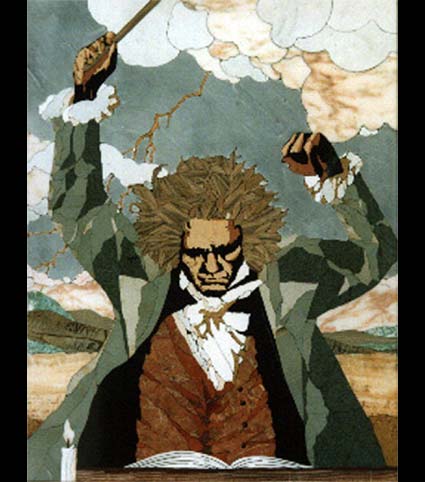| |
 |
| |
|
|
|
|
The Ninth Symphony in D minor, Opus 125, composed by Beethoven in 1822 to 1824, was dedicated to Friedrich Wilhelm III, King of Prussia, and first performed in Vienna on the 7th May 1824. Ignaz Schuppanzigh directed the orchestra, in the presence of the composer. This symphony was at once a great success, and it's premier gave cause for five recalls, whereas the Emperor was only able to benefit from three. Beethoven constructed his symphony and added at the end of the fourth movement an Ode to Joy. To add an ending with choir was an idea on which he had mused upon since 1807. Beethoven manifested an intention to compose a work containing inspiration from the Ode to Joy of Friedrich von Schiller as early as 1792 (all scolars do not agree on this). In 1799, Beethoven sketched a setting to music, in the form of a lied, which then served to lead towards Leonore-Fidelio, his opera. The other sketches are found in his notebooks of 1814-1815. Finally, Beethoven adapted the text for his ninth symphony. For this purpose, he prompted a version of 1803 revised by Schiller himself. As for the musical theme of the Ode to Joy, it finds its origins particularly in the Fantasy for choir, piano and orchestra, opus 80. The Ode to Joy corresponds to Beethoven's fraternal ideals, where his incessant willingness to compose a work to the measure of Schiller's writing: «Man is to all men a brother Which embraces all beings! - A kiss to all the world!». |
Since then, it has not ceased to be performed around the world, by the great ensembles, and conducted by the leading conductors. It's total length (unheard-of for the time) is 60 to 70 minutes, depending on the performance. |
|
Orchestration: The orchestra, the most important that Beethoven had employed, comprises:
Structure:
|
The finale comprises 9 parts:
|
 |
In December 1989, in Berlin, shortly after the fall of the wall, Leonard Bernstein who conducted the 9th Symphony, for the first time used the word «Freiheit». Incidentally, it may be remembered that, in 1986, the theme of the Ode to Joy was chosen for the European Anthem. |
|
Since the age of 78s to our times, the 9th Symphony has been recorded a great number of times, we have counted no fewer than 150 versions! The 9th is to be found, of course, included in the 80 complete signals on this site. The majority of the great conductors have recorded the nine symphonies, but certainly, for example Ferenc Friscay disappear prema turely,and could not complete their cycle. Nevertheless there exists many single 9ths, some recorded “live”, in concert. Citing some interpretations allows the conductors of the past (this list is by no means definitive):There also exist transcriptions of this symphony, for piano, but also for other instruments. Point out also the re orchestrations of Gustav Mahler. |
The CD “Serge Kousevitzky in Paris” recaptures the recording made in Paris, during a concert at the Théâtre des Champs-Elysées on 5th May 1950. It includes the Symphony no. 9, opus 125 in D minor, performed by the Orchestre National de France, conducted by Serge Koussevitzky. The Ode to Joy is sung in French, unfortunately the words are barely audible. Soloists: Janine Micheau, Solange Michel, Georges Jouatte, Charles Cambon. The choir of the RTF is conducted by René Alix. |
|
There is also another CD without the rehearsal of the Boston Symphony: |
| Many thanks to Melanie PIDDOCKE for her translation of this page from French into English |
| © Daniel ACHACHE - Dominique PREVOT |
 |
 |
|
|||||||||||||||||||